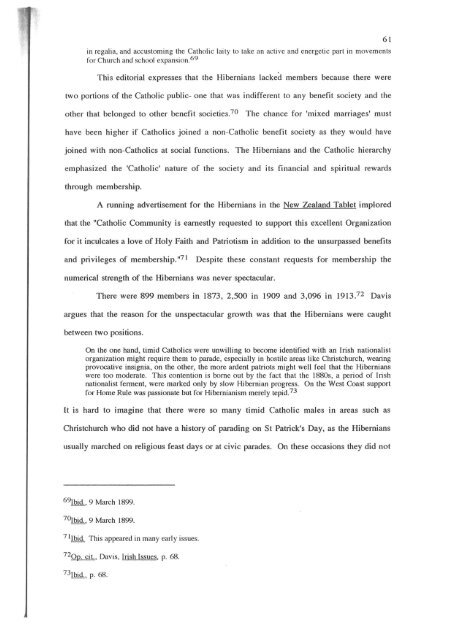TRANSPLANTED IRISH INSTITUTIONS - University of Canterbury
TRANSPLANTED IRISH INSTITUTIONS - University of Canterbury
TRANSPLANTED IRISH INSTITUTIONS - University of Canterbury
Create successful ePaper yourself
Turn your PDF publications into a flip-book with our unique Google optimized e-Paper software.
in regalia, and accustoming the Catholic laity to take an active and energetic part in movements<br />
for Church and school expansion 69<br />
This editorial expresses that the Hibernians lacked members because there were<br />
two portions <strong>of</strong> the Catholic public- one that was indifferent to any benefit society and the<br />
61<br />
other that belonged to other benefit societies. 7o<br />
The chance for 'mixed marriages' must<br />
have been higher if Catholics joined a non-Catholic benefit society as they would have<br />
joined with non-Catholics at social functions. The Hibernians and the Catholic hierarchy<br />
emphasized the 'Catholic' nature <strong>of</strong> the society and its financial and spiritual rewards<br />
through membership.<br />
A running advertisement for the Hibernians in the New Zealand Tablet implored<br />
that the "Catholic Community is earnestly requested to support this excellent Organization<br />
for it inculcates a love <strong>of</strong> Holy Faith and Patriotism in addition to the unsurpassed benefits<br />
and privileges <strong>of</strong> membership. "71<br />
Despite these constant requests for membership the<br />
numerical strength <strong>of</strong> the Hibernians was never spectacular.<br />
There were 899 members in 1873, 2,500 in 1909 and 3,096 In 1913. 72 Davis<br />
argues that the reason for the unspectacular growth was that the Hibernians were caught<br />
between two positions.<br />
On the one hand, timid Catholics were unwilling to become identified with an Irish nationalist<br />
organization might require them to parade, especially in hostile areas like Christchurch, wearing<br />
provocative insignia, on the other, the more ardent patriots might well feel that the Hibernians<br />
were too moderate. This contention is borne out by the fact that the 1880s, a period <strong>of</strong> Irish<br />
nationalist ferment, were marked only by slow Hibernian progress. On the West Coast support<br />
for Home Rule was passionate but for Hibemianism merely tepid.?3<br />
It is hard to imagine that there were so many timid Catholic males in areas such as<br />
Christchurch who did not have a history <strong>of</strong> parading on St Patrick's Day, as the Hibernians<br />
usually marched on religious feast days or at civic parades. On these occasions they did not<br />
69Jbid., 9 March 1899.<br />
7Orbid., 9 March 1899.<br />
7 1 Ibid. This appeared in many earl y issues.<br />
720p. cit., Davis, Irish Issues, p. 68.
















